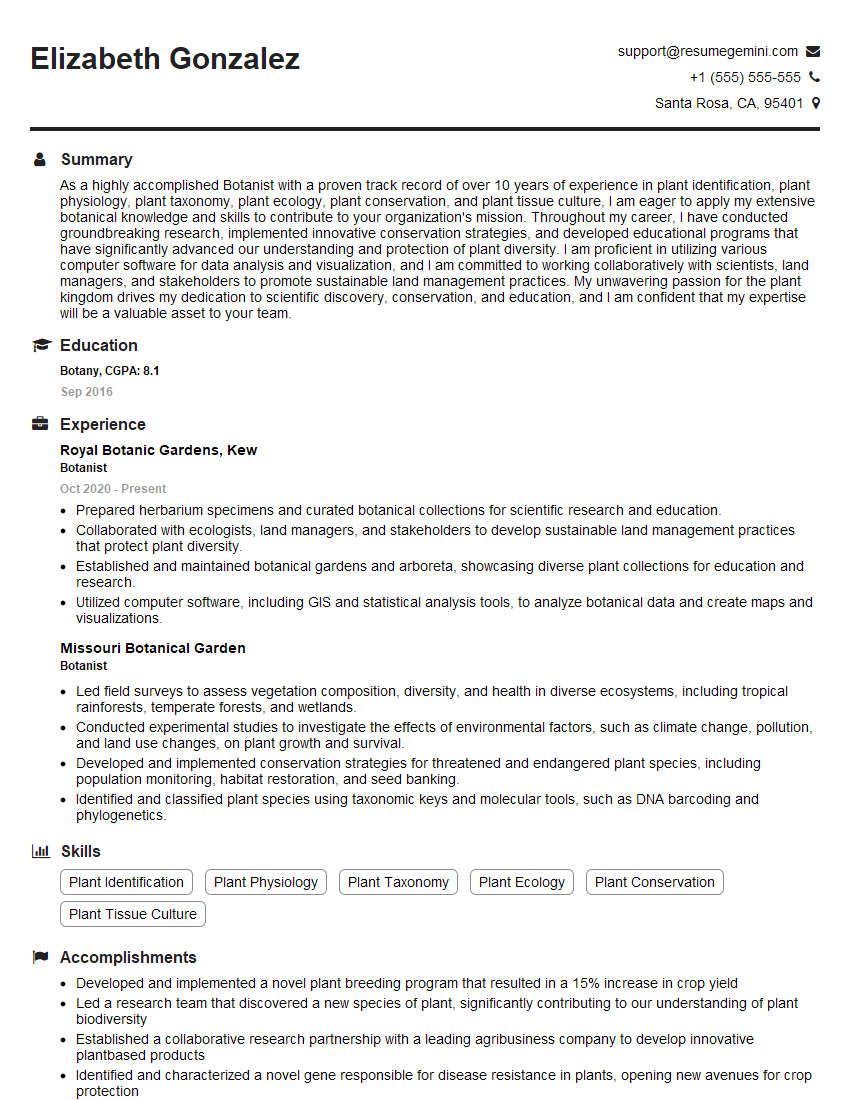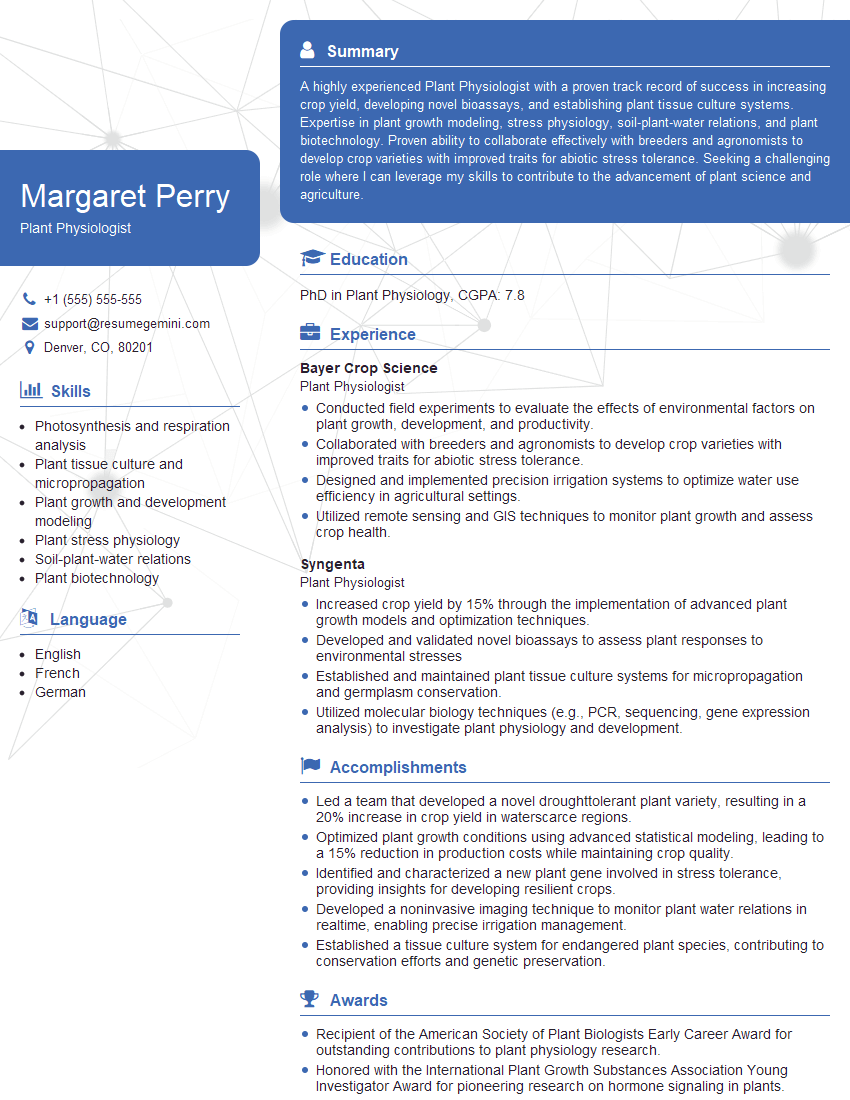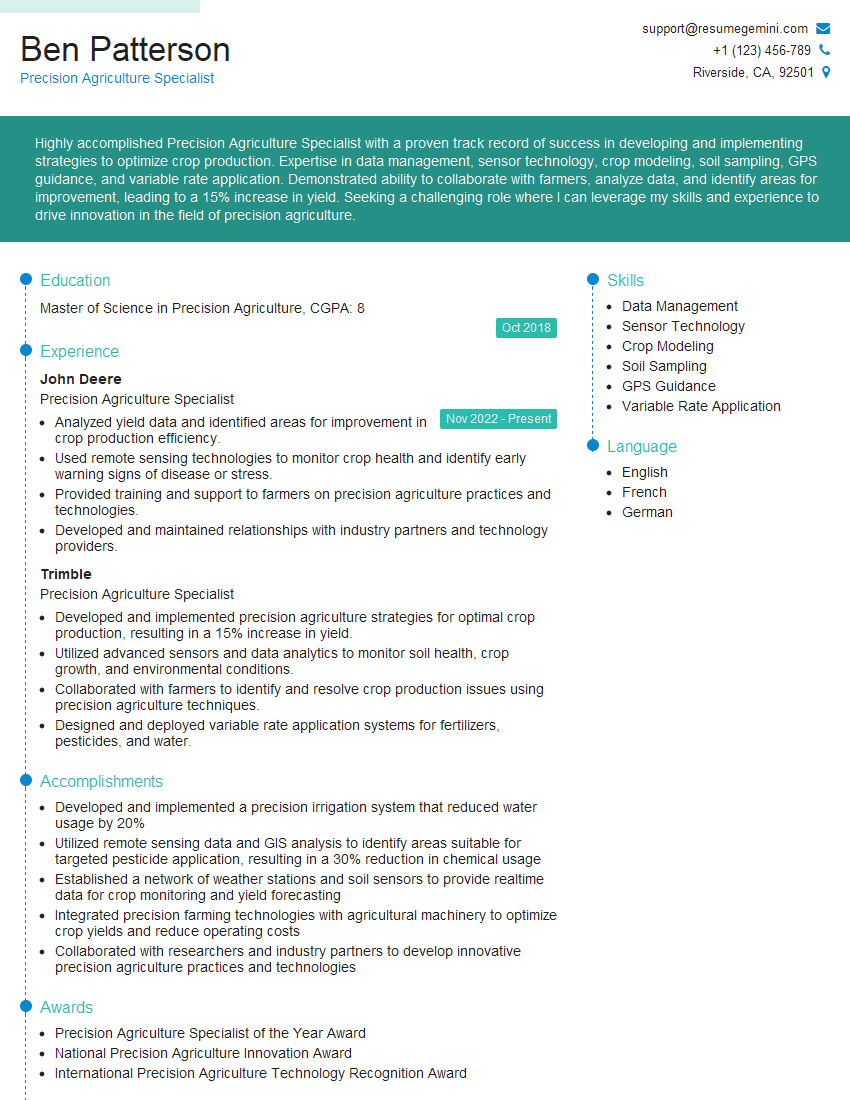The right preparation can turn an interview into an opportunity to showcase your expertise. This guide to Leaf Size Analysis interview questions is your ultimate resource, providing key insights and tips to help you ace your responses and stand out as a top candidate.
Questions Asked in Leaf Size Analysis Interview
Q 1. Explain the significance of leaf size in plant physiology.
Leaf size is a crucial aspect of plant physiology, influencing numerous physiological processes and ultimately impacting plant growth, survival, and productivity. Think of it as the plant’s primary interface with its environment – a larger leaf surface area means more opportunities for light capture, gas exchange (photosynthesis and respiration), and water loss through transpiration. Conversely, smaller leaves can be advantageous in arid environments by minimizing water loss.
Leaf size directly affects photosynthetic capacity. Larger leaves can capture more sunlight, leading to increased rates of photosynthesis, but this benefit is balanced against the increased risk of water loss and potential for damage from herbivores or strong winds. The optimal leaf size is a balance struck between these opposing forces, and it varies greatly depending on the species and environmental conditions.
Q 2. Describe different methods for measuring leaf area.
Measuring leaf area can be achieved through several methods, ranging from simple to sophisticated techniques. The choice depends on the resources available, the accuracy required, and the number of leaves to be measured.
Direct Measurement: This involves using a ruler or planimeter to directly measure leaf length, width, and shape. This is suitable for small numbers of leaves but is time-consuming and prone to errors for complex leaf shapes.
Image Analysis: This involves taking a digital image of the leaf and using image analysis software to calculate the area. This method is faster and more accurate than direct measurement, especially for irregularly shaped leaves. Many free and commercial software packages are available for this purpose.
Leaf Area Meters: These portable devices use optical sensors to quickly and accurately measure leaf area. They are particularly useful for large-scale studies or field work where many leaves need to be measured.
Geometric Approximations: For simpler leaf shapes, geometric formulas (like area of an ellipse) can be used, but these methods usually lack accuracy for most plant species.
Q 3. What is Leaf Area Index (LAI) and how is it calculated?
Leaf Area Index (LAI) is a dimensionless quantity that represents the total one-sided leaf area per unit ground surface area. It’s a key indicator of canopy structure and function, providing insights into the photosynthetic capacity and overall productivity of a plant community. Imagine a forest – LAI quantifies how much leaf area is present above each square meter of ground.
LAI is usually calculated by measuring the leaf area of a representative sample of plants within a specific area, then dividing the total leaf area by the ground area. Different methods exist for measuring LAI in the field, including direct sampling, indirect methods using light sensors (measuring the light interception by the canopy), and remote sensing techniques using satellites or drones. A simplified calculation would be: LAI = Total leaf area / Ground area
Q 4. How does leaf size relate to plant productivity?
Leaf size has a strong relationship with plant productivity. Larger leaves generally have a greater photosynthetic capacity, leading to increased biomass production. However, this relationship is not always linear. Very large leaves can be susceptible to damage and increased water loss. The optimal leaf size is dependent on environmental factors such as light availability, water availability, temperature, and nutrient levels.
For example, shade-tolerant plants often have larger leaves to maximize light capture in low-light conditions. In contrast, plants adapted to arid environments typically have smaller leaves to minimize water loss through transpiration. It’s a complex interplay; while larger leaves can lead to increased photosynthesis, they might also result in higher respiration rates, ultimately impacting the net carbon gain and overall productivity.
Q 5. Discuss the impact of environmental factors on leaf size.
Environmental factors significantly influence leaf size. Light availability, water availability, temperature, and nutrient availability all play crucial roles. Plants growing in shaded environments often develop larger leaves to maximize light interception, while those in full sunlight tend to have smaller leaves to avoid excessive water loss and damage from intense radiation.
Water scarcity leads to smaller leaves, a strategy to reduce transpiration and conserve water. Nutrient deficiency can also result in smaller leaves, as the plant lacks the resources for optimal growth. Similarly, low temperatures can slow down leaf growth resulting in smaller leaves. These adaptations demonstrate the plasticity of leaf size in response to environmental cues – a plant’s way of optimizing its physiology for survival and reproduction in its specific habitat.
Q 6. Explain the relationship between leaf size and water use efficiency.
Leaf size is intrinsically linked to water use efficiency (WUE), which is the ratio of carbon gained through photosynthesis to water lost through transpiration. Plants with smaller leaves generally exhibit higher WUE because they have a lower surface area for transpiration, reducing water loss while still maintaining sufficient photosynthetic capacity.
However, this relationship is not universally true. Other factors, such as stomatal density and leaf structure, also significantly influence WUE. For example, a plant with smaller leaves but many stomata might not have higher WUE than a plant with larger leaves and fewer stomata. Therefore, considering leaf size in isolation from other leaf characteristics may not fully explain variations in WUE.
Q 7. How can leaf size analysis be used in precision agriculture?
Leaf size analysis plays a vital role in precision agriculture by providing valuable information for optimizing crop management practices. By monitoring leaf area, farmers can assess crop health, estimate biomass, and predict yield. This information is then used for site-specific management decisions, such as variable-rate fertilization and irrigation. Drones equipped with multispectral sensors can efficiently measure LAI across large fields, providing a rapid and comprehensive assessment of crop growth and health. This allows for timely interventions, maximizing resource use efficiency and minimizing environmental impact.
For instance, if LAI is consistently low in a specific area of a field, it might indicate nutrient deficiency or water stress, prompting the farmer to apply targeted fertilizers or irrigation to that area. This contrasts with traditional approaches where the whole field receives the same treatment, regardless of the needs of individual parts. Leaf size analysis, therefore, allows for a more precise, efficient, and sustainable approach to agriculture.
Q 8. Describe the application of remote sensing techniques in leaf size analysis.
Remote sensing, particularly using high-resolution imagery from satellites or drones, offers a powerful, non-invasive method for analyzing leaf size across vast areas. Instead of manually measuring leaves, we can use spectral data and image analysis techniques to estimate leaf area. For example, Normalized Difference Vegetation Index (NDVI) data, which reflects plant greenness, can be correlated with leaf size in certain contexts. Sophisticated algorithms then process this information to derive leaf area estimates. This is particularly useful for monitoring large-scale changes in vegetation, such as forest health assessments or agricultural yield predictions. Imagine trying to measure the leaf area of an entire forest manually – it’s simply not feasible! Remote sensing allows us to scale up leaf size analysis to a level impossible through traditional methods. We can use object-based image analysis (OBIA) techniques to segment individual crowns and estimate leaf sizes based on the measured area.
Specific techniques include multispectral and hyperspectral imagery, LiDAR (Light Detection and Ranging) for 3D structure determination, and photogrammetry to create detailed 3D models of canopies for leaf size estimation. The choice of technique depends on factors such as the spatial resolution required, the scale of the study, and the availability of technology.
Q 9. What are the limitations of using image analysis for leaf size measurement?
While image analysis provides a rapid and efficient way to measure leaf size, several limitations exist. Firstly, image resolution is crucial; low-resolution images may not accurately capture the details of small leaves, leading to underestimation of leaf size. Secondly, occluded leaves or leaves obscured by shadows will be missed, potentially biasing the results. For instance, if a dense canopy blocks sunlight, it will be difficult to capture the sizes of lower leaves. Thirdly, the accuracy of image analysis is heavily reliant on the quality of the image and the algorithm used. Poor image quality (due to blur, noise, etc.) can lead to significant measurement errors. Calibration is also extremely important; the image needs to be properly scaled and oriented to ensure accurate measurements. Finally, image analysis methods may struggle to differentiate between leaves and other objects of similar color and shape, leading to false positives or negatives in the analysis.
For example, using a simple thresholding algorithm on an image with variable lighting conditions might misclassify shadowed areas as parts of a leaf, leading to an overestimation of leaf size. Advanced algorithms such as machine learning can help address some of these issues but require extensive training data and expertise.
Q 10. Explain how leaf size varies across different plant species.
Leaf size exhibits an astonishing diversity across plant species, reflecting adaptations to different environments and ecological strategies. Consider the dramatic difference between the tiny leaves of a desert plant like a creosote bush, which minimize water loss, and the enormous leaves of a tropical rainforest plant like a banana tree, which maximize light capture. These variations are influenced by factors such as climate (temperature, sunlight, rainfall), nutrient availability, and the plant’s growth form (e.g., tree, shrub, herb).
Generally, we see smaller leaves in arid and windy environments, where minimizing water loss and structural damage is crucial. Conversely, larger leaves are common in high-light environments with ample water availability. Even within the same species, leaf size can vary depending on environmental conditions (e.g., sun vs. shade leaves). This variation can be incredibly important for ecological studies, as understanding leaf size variation can help us predict plant responses to environmental changes, such as drought or climate warming.
Q 11. How does leaf size change throughout a plant’s life cycle?
Leaf size is not static throughout a plant’s life cycle. Young seedlings often have smaller leaves than mature plants. This is because the plant needs to invest its limited resources efficiently in its early stages of growth. As the plant matures and its root system develops, enabling greater nutrient and water uptake, leaf size typically increases. However, this pattern is not universal; some plants exhibit a decrease in leaf size during certain life stages. Leaf senescence (aging) will inevitably lead to a decrease in leaf size as the leaf withers and dies. In some species, leaf size is affected by the time of year, with the largest leaves developing during peak growing seasons when environmental conditions are optimal.
The growth curve of leaf size can be studied using growth models, allowing predictions about future sizes and the timing of key developmental stages. This is useful for horticulture and agriculture, for example, to optimize growing conditions for maximum yield and improve crop management strategies.
Q 12. Describe the role of leaf size in plant adaptation to different environments.
Leaf size plays a critical role in plant adaptation to various environments. As mentioned previously, smaller leaves are advantageous in arid climates, where water conservation is paramount. The reduced surface area minimizes water loss through transpiration. In contrast, larger leaves are beneficial in low-light conditions, as they can intercept more sunlight for photosynthesis. Leaf size is also linked to plant tolerance of extreme temperatures. Plants in extremely hot environments may have smaller, thicker leaves to reduce heat stress, while plants in cold environments may have larger leaves to capture more sunlight and warmth. Windy environments often favor smaller, more robust leaves that can withstand damage.
Consider the case of succulent plants in deserts: their thick, small leaves, often modified into spines, are highly adapted to minimize water loss and protect against herbivores. In contrast, the giant leaves of water lilies floating on the surface of ponds maximize light capture in a shaded environment. This shows how leaf size is intimately tied to a plant’s survival strategy within its unique ecological niche.
Q 13. How can leaf size data be used to model plant growth?
Leaf size data is essential for constructing accurate plant growth models. By incorporating leaf area as a key variable, we can predict biomass accumulation, photosynthetic rates, and overall plant growth. These models often incorporate allometric relationships (explained in the next answer) to link leaf size to other plant characteristics, such as stem diameter, height, and root mass. Leaf area index (LAI), which represents the total leaf area per unit of ground area, is a critical input for many ecosystem models that predict carbon sequestration, water use efficiency, and other ecological processes.
For instance, in agriculture, models incorporating leaf size data can help optimize irrigation strategies or fertilization schedules to enhance crop yields. In forestry, such models can predict the growth of individual trees and entire stands, which is crucial for sustainable forest management practices.
Q 14. Explain the concept of allometry in relation to leaf size.
Allometry refers to the study of the relationship between the size of different body parts within an organism. In the context of leaf size, allometry describes the scaling relationships between leaf size and other plant traits, such as plant height, stem diameter, or total biomass. These relationships are often expressed mathematically using power laws. For example, a common allometric relationship is that leaf area scales approximately to the square of plant height. This means that as a plant gets taller, its leaf area increases disproportionately. This reflects the fact that a taller plant needs more leaves to capture the necessary amount of sunlight for photosynthesis.
Understanding allometric relationships is crucial for estimating various plant characteristics based on a single measurement (e.g., estimating total biomass from leaf area). Allometric equations are routinely incorporated into plant growth models to improve accuracy and reduce the number of parameters that need to be measured directly. Deviation from expected allometric scaling can also indicate stress or changes in environmental conditions. For example, smaller leaves than predicted for a given plant height might indicate nutrient deficiency.
Q 15. What statistical methods are commonly used in leaf size analysis?
Leaf size analysis often involves descriptive statistics like mean, median, and standard deviation to summarize leaf area, length, and width. We also use inferential statistics to compare leaf sizes across different groups or treatments. Common methods include:
- t-tests: Comparing the mean leaf size of two groups (e.g., plants under different nutrient levels).
- ANOVA (Analysis of Variance): Comparing the mean leaf size of three or more groups (e.g., plants treated with various fertilizers).
- Regression analysis: Examining the relationship between leaf size and other variables (e.g., plant height, environmental factors). Linear regression is common, but other models may be necessary depending on the data distribution.
- Correlation analysis: Assessing the strength and direction of the association between leaf size and other variables.
- Non-parametric tests: Such as Mann-Whitney U test or Kruskal-Wallis test, when data doesn’t meet the assumptions of parametric tests (e.g., normality).
For example, a t-test could be used to determine if there’s a statistically significant difference in leaf area between a drought-stressed group of plants and a control group. ANOVA could compare leaf size across multiple irrigation levels.
Career Expert Tips:
- Ace those interviews! Prepare effectively by reviewing the Top 50 Most Common Interview Questions on ResumeGemini.
- Navigate your job search with confidence! Explore a wide range of Career Tips on ResumeGemini. Learn about common challenges and recommendations to overcome them.
- Craft the perfect resume! Master the Art of Resume Writing with ResumeGemini’s guide. Showcase your unique qualifications and achievements effectively.
- Don’t miss out on holiday savings! Build your dream resume with ResumeGemini’s ATS optimized templates.
Q 16. Describe different software packages used for leaf size analysis.
Several software packages facilitate leaf size analysis. The choice depends on the complexity of the analysis and the data format.
- ImageJ/Fiji: A free, open-source image analysis program widely used for measuring leaf area from scanned images or photographs. It’s user-friendly and allows for automated measurements of large datasets.
- LeafAnalyzer: A specialized software focusing on automated leaf shape analysis.
- R: A powerful statistical programming language with numerous packages dedicated to data analysis and visualization. Packages like ‘ggplot2’ are invaluable for creating publication-quality graphs, and packages like ‘vegan’ offer advanced statistical analysis for ecological studies.
- MATLAB: Another powerful option for image processing and statistical analysis, especially useful if you’re dealing with complex data or need to create custom algorithms.
- Specialized plant phenotyping software: Various commercial software packages integrate image processing, analysis, and modeling capabilities specifically for plant research. These often have advanced features but come at a higher cost.
For instance, if I needed to quickly measure the area of hundreds of leaves from scanned images, ImageJ would be an efficient tool. If I need more complex statistical analysis involving many variables, R would be my preferred choice.
Q 17. How do you handle outliers in leaf size data?
Outliers in leaf size data can significantly skew results. Handling them requires careful consideration.
- Visual Inspection: Begin by creating histograms and box plots to visually identify potential outliers. These are data points that are unusually far from the rest of the data.
- Statistical Methods: Methods like the Interquartile Range (IQR) can be used to identify outliers mathematically. Values falling outside 1.5 times the IQR below the first quartile or above the third quartile are often considered outliers.
- Data Transformation: Sometimes, transforming the data (e.g., using a logarithmic transformation) can reduce the influence of outliers.
- Robust Statistical Methods: Use statistical methods less sensitive to outliers, such as median instead of mean, or non-parametric tests instead of parametric tests.
- Investigate the Cause: Rather than simply removing outliers, investigate the reason for their occurrence. It might indicate a biological phenomenon or measurement error that warrants further investigation. Maybe there was an error in measurement or a particular plant was affected by a disease.
Removing outliers without justification is generally discouraged. Documenting the reasons for your approach and any decisions to remove data points is essential for reproducibility and transparency.
Q 18. Explain the importance of proper sampling techniques in leaf size analysis.
Proper sampling is crucial for obtaining representative and unbiased results. A poorly designed sampling strategy can lead to erroneous conclusions.
- Random Sampling: Each plant or leaf within the population should have an equal chance of being selected to minimize bias.
- Stratified Sampling: If your population is heterogeneous (e.g., different plant ages or growth stages), stratify the population into subgroups and randomly sample from each stratum to ensure representation across groups.
- Sufficient Sample Size: The number of samples needed depends on the variability within the population and the desired level of precision. Insufficient samples can lead to unreliable results.
- Replicates: Multiple measurements from each plant or leaf (replicates) improve the precision and accuracy of the analysis.
- Sampling Design: The sampling design should be clearly documented to allow others to understand and reproduce the study.
Imagine studying leaf size across a field. Randomly selecting leaves from various locations across the field would ensure your sample is representative of the entire field. Failing to do so could lead to biased results if, for instance, you only sample leaves in one sunny spot.
Q 19. How can leaf size analysis be used to assess plant health?
Leaf size is a valuable indicator of plant health and can reveal stresses.
- Nutrient Deficiency: Smaller than expected leaves can indicate nutrient deficiencies (e.g., nitrogen, phosphorus).
- Water Stress: Drought often leads to smaller leaves as plants try to conserve water.
- Disease or Pest Infestation: Leaf size can be affected by pathogens and pests that damage leaf tissue.
- Light Availability: Plants growing in shaded areas may have larger leaves compared to those in full sunlight to maximize light capture.
- Genetic Factors: Leaf size varies due to genetic differences among plant varieties.
For example, if the leaves of a plant are significantly smaller than expected for its species and age, it could suggest a nutritional problem. Comparing the leaf size to a control group can help confirm a potential stress or deficiency.
Q 20. Discuss the relationship between leaf size and nutrient uptake.
Leaf size and nutrient uptake are closely related. Larger leaves generally have a greater surface area for photosynthesis and nutrient absorption. This allows for more efficient uptake of nutrients from the soil and atmosphere. However, it’s a complex relationship.
- Nutrient Availability: Abundant nutrient supply can support larger leaf growth. Conversely, nutrient-poor conditions may limit leaf expansion.
- Photosynthesis: Larger leaves can capture more sunlight, leading to increased photosynthesis and, consequently, greater nutrient demand.
- Resource Allocation: Plants allocate resources (including nutrients) to optimize growth. Nutrient availability influences how much is invested in leaf size versus other plant parts.
- Leaf Morphology: Leaf thickness and shape also influence nutrient uptake and photosynthetic efficiency. A thin leaf may absorb nutrients less efficiently even if its surface area is larger.
Think of leaves as solar panels. Bigger panels generate more energy, but they also require more resources to construct and maintain. Similarly, larger leaves need more nutrients to function effectively.
Q 21. How can leaf size data be integrated with other plant traits for a comprehensive analysis?
Integrating leaf size data with other plant traits provides a more comprehensive understanding of plant growth and response to environmental factors.
- Plant Height: Leaf size can be correlated with plant height. Taller plants may have larger leaves, or the relationship may depend on the environmental conditions.
- Biomass: Leaf size is a component of total plant biomass, and understanding their relationships can improve biomass estimation models.
- Chlorophyll Content: Leaf size can be analyzed alongside chlorophyll concentration to understand photosynthetic capacity.
- Leaf Thickness: Integrating leaf size with thickness provides insights into leaf structure and function.
- Stomatal Density: Combining leaf size with stomatal density can provide insights into gas exchange and water use efficiency.
By combining data on leaf size with other traits, we can develop more robust models of plant growth and predict responses to various environmental stresses. For example, modeling the relationship between leaf size, biomass, and chlorophyll content can improve predictions of crop yield.
Q 22. Explain the use of leaf size data in assessing the impact of climate change on vegetation.
Leaf size, a readily measurable plant trait, serves as a sensitive indicator of environmental change, particularly climate change. Changes in temperature, precipitation, and atmospheric CO2 directly influence photosynthetic rates and water use efficiency, both of which significantly impact leaf size. For example, increased CO2 levels can initially stimulate growth, leading to larger leaves, but prolonged drought conditions can cause smaller leaves to conserve water. By analyzing historical and current leaf size data from various locations, researchers can track these changes over time and create models predicting future vegetation responses to climate change. This allows for more accurate assessments of ecosystem vulnerability and assists in developing mitigation strategies.
Imagine comparing leaf size data from a forest in 1950 to the same forest today. A significant decrease in average leaf size might suggest a prolonged drought or other stressor associated with climate change. Conversely, an increase might, initially, signal increased CO2 fertilization, but further investigation is needed to contextualize this finding with other environmental factors.
Q 23. What are the ethical considerations related to collecting and using leaf size data?
Ethical considerations in leaf size data collection and use are multifaceted. Firstly, obtaining permission to access and sample vegetation from private or protected lands is paramount. Respect for local communities and indigenous knowledge is vital, especially in regions with biodiversity hotspots. Researchers must ensure they are not disturbing or harming sensitive ecosystems during data collection. Data transparency and sharing are also critical; openly accessible data allows for independent verification and replication of studies. Finally, the potential misuse of data for commercial gain, without proper attribution or compensation, must be avoided. The ethical conduct of leaf size analysis is essential for maintaining the integrity of scientific research and building trust with communities.
Q 24. How can leaf size analysis contribute to improving crop yields?
Leaf size analysis can significantly contribute to improving crop yields by providing valuable insights into plant health and stress response. Larger leaves, within optimal ranges, generally indicate higher photosynthetic capacity, leading to increased biomass production and ultimately, higher yields. Leaf size analysis can help breeders select cultivars with superior leaf characteristics for specific environmental conditions. For instance, identifying varieties with smaller, thicker leaves may be crucial for drought-prone regions. Furthermore, analyzing leaf size changes in response to different fertilizer treatments or irrigation strategies can optimize crop management practices for maximum yield. Precision agriculture utilizes this data to tailor interventions at the individual plant level.
For example, a farmer might compare leaf size in experimental plots treated with different nitrogen fertilizers. Larger leaves in plots with a particular nitrogen concentration suggest an optimal fertilization strategy for maximizing yields.
Q 25. Describe the challenges associated with scaling up leaf size analysis for large-scale studies.
Scaling up leaf size analysis for large-scale studies presents several challenges. The sheer volume of data involved requires robust data management and computational resources. Automated image processing techniques are crucial for efficient analysis of thousands or millions of images. However, these automated methods require rigorous validation to ensure accuracy. Another significant challenge is maintaining consistency in data collection across diverse geographical locations and environmental conditions. Standardization of sampling protocols, measurement techniques, and data processing procedures is essential to avoid bias. Finally, the costs associated with large-scale field surveys, data acquisition, and analysis can be substantial, often requiring multi-institutional collaborations and funding.
Q 26. Explain how leaf size analysis is used in ecological studies.
Leaf size analysis plays a vital role in ecological studies by providing insights into plant adaptation and competition, ecosystem structure and functioning, and responses to environmental change. Leaf size is closely linked to resource acquisition strategies. For example, species in high-light environments often have smaller leaves to reduce water loss, while those in shaded areas often exhibit larger leaves to maximize light capture. By analyzing leaf size distributions within communities, ecologists can infer competitive dynamics and niche partitioning. Moreover, changes in average leaf size over time can indicate ecosystem-level responses to disturbances, such as fire or invasive species.
Imagine studying a forest recovering from a wildfire. Changes in leaf size of dominant species could indicate their success or struggle to re-establish themselves, revealing insights into the overall ecosystem’s resilience.
Q 27. Discuss the future trends and advancements in leaf size analysis techniques.
Future trends in leaf size analysis will be driven by advancements in technology and data science. The increasing availability of high-resolution remote sensing data, such as drone imagery and satellite data, will enable large-scale leaf size estimations across vast geographical areas. The integration of artificial intelligence (AI) and machine learning (ML) algorithms will allow for automated image analysis, improving the efficiency and accuracy of leaf size measurements. Furthermore, the development of more sophisticated statistical models will enable a more comprehensive understanding of leaf size variation and its ecological implications, considering factors such as plant ontogeny and environmental heterogeneity.
For example, we can expect AI-powered tools to automatically identify and measure leaves in high-resolution images, significantly reducing the time and effort required for data acquisition.
Q 28. How would you approach analyzing leaf size data from a diverse set of plant species?
Analyzing leaf size data from a diverse set of plant species requires a careful consideration of both inter- and intra-specific variability. Simple averaging across all species would mask significant biological differences. A robust approach involves employing phylogenetic comparative methods to account for evolutionary relationships among species. This helps to control for shared ancestry, allowing for a more accurate assessment of the independent effects of environmental factors on leaf size. Statistical methods that account for the non-normal distribution of leaf size data, such as generalized linear models (GLMs) or non-parametric tests, are often necessary. Finally, integrating other plant traits, such as leaf thickness, specific leaf area (SLA), and photosynthetic capacity, can provide a more holistic understanding of plant adaptations and ecosystem functioning.
For instance, a GLM could model leaf size as a function of environmental variables (e.g., precipitation, temperature) and phylogenetic relatedness, allowing for a comparison of leaf size adaptation across different evolutionary lineages.
Key Topics to Learn for Leaf Size Analysis Interview
- Allometry and Leaf Size: Understanding the relationship between leaf size and other plant traits, including species-specific scaling relationships.
- Measurement Techniques: Mastering various methods for accurately measuring leaf area, length, width, and perimeter, including both traditional and digital techniques.
- Data Analysis and Statistics: Proficiency in using statistical software (e.g., R, Python) to analyze leaf size data, including descriptive statistics, regression analysis, and ANOVA.
- Environmental Influences: Exploring how environmental factors (light, water, nutrients) influence leaf size and shape, and the underlying physiological mechanisms.
- Leaf Size and Plant Function: Understanding the ecological significance of leaf size variation, including its impact on photosynthesis, water use efficiency, and herbivory.
- Applications in Research: Familiarizing yourself with practical applications of leaf size analysis in various fields, such as ecology, botany, and agriculture.
- Interpreting Results: Developing the ability to critically evaluate and interpret leaf size data in the context of research questions and hypotheses.
- Problem-Solving: Practicing identifying and troubleshooting potential issues in leaf size data collection and analysis.
- Advanced Techniques: Exploring more advanced topics like image analysis for automated leaf size measurement and modeling leaf size distribution within populations.
Next Steps
Mastering Leaf Size Analysis opens doors to exciting career opportunities in research, conservation, and agricultural science. A strong understanding of this field significantly enhances your marketability and allows you to contribute meaningfully to various projects. To maximize your job prospects, create an ATS-friendly resume that effectively highlights your skills and experience. ResumeGemini is a trusted resource that can help you build a professional and impactful resume. Examples of resumes tailored to Leaf Size Analysis are available to guide you.
Explore more articles
Users Rating of Our Blogs
Share Your Experience
We value your feedback! Please rate our content and share your thoughts (optional).
What Readers Say About Our Blog
Hi, I represent an SEO company that specialises in getting you AI citations and higher rankings on Google. I’d like to offer you a 100% free SEO audit for your website. Would you be interested?
good







